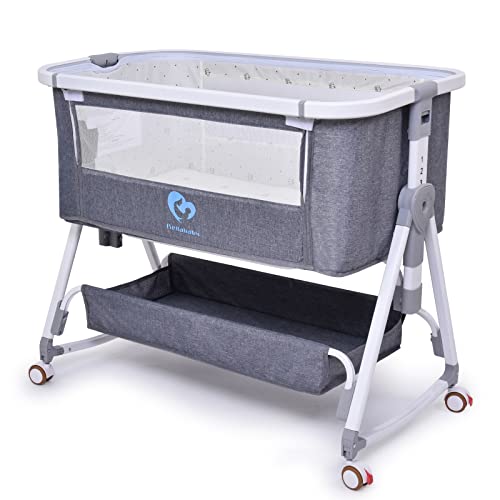14 Creative Ways To Spend Leftover Bedside Sleeper Budget
The Ultimate Guide to Baby Bedside Sleepers: Why They're a Wise Investment for New Parents
Welcoming a newborn into the household brings tremendous delight, but it likewise postures unique difficulties, specifically worrying sleep. Among Attachable Bedside Crib find is making use of a baby bedside sleeper. This article will explore what baby bedside sleepers are, their advantages, types available, and ideas for picking the best one. Additionally, common FAQs will be resolved to assist new parents make informed choices.
What is a Baby Bedside Sleeper?
A baby bedside sleeper, also known as a co-sleeper or bedside crib, is a special sleeping arrangement created to keep infants near their parents throughout the night while preserving a safe sleeping environment. These sleep options typically connect to the side of the moms and dad's bed, enabling easy access to the baby without the dangers associated with sharing a bed directly.
Advantages of Using a Baby Bedside Sleeper
1. Boosted Bonding
Having a baby nearby during sleep fosters instant attachment and bonding. Parents can easily react to their baby's needs throughout the night, providing peace of mind and convenience.
2. Benefit for Nighttime Feeding
Breastfeeding moms, in particular, discover bedside sleepers vital. They can quickly reach their baby for breastfeeding without having to get out of bed, which is especially advantageous during those tiring early months.
3. Safer Sleeping Environment
Bedside sleepers abide by security standards created for infants. Unlike Info -sleeping in an adult bed, where parents may inadvertently roll over onto the baby, bedside sleepers use a separate sleep space while being within arm's reach.
4. Transition to a Crib
Utilizing a baby bedside sleeper can help prepare the baby for transitioning to a crib later on. They offer a similar sleeping environment, assisting the shift when the time comes.
5. Support of Independent Sleeping
With the capability to position their baby in a separate sleeper, parents promote a degree of independence for the infant, which can be advantageous in future sleep training efforts.
Types of Baby Bedside Sleepers
When thinking about baby bedside sleepers, parents will discover a variety of designs available. Below is a list of the common types:
1. Co-Sleepers
Co-sleepers are developed to attach securely to the side of the parent's bed. They can be easily unlatched and eliminated, making them versatile for bedtime regimens.
2. Moses Baskets
Though not conventional bedside sleepers, Moses baskets can be conveniently put beside the moms and dad's bed. They are portable, making them terrific for travel or moving within the home.
3. Portable Cribs
While larger than other choices, portable cribs can serve the very same function. They are an excellent choice for parents who may wish to move their baby's sleeping environment around the home easily.
4. Load and Plays
Similar to portable cribs, pack and plays come equipped with a bassinet function, permitting them to work as a bedside sleeper. They typically offer various performances and storage alternatives.
5. Adjustable Bedside Sleepers
Some sleeper models feature adjustable height settings, which enable them to fit completely next to various types of beds. This flexibility is an appealing function for many parents.
Picking the Right Baby Bedside Sleeper
When selecting a bedside sleeper, a number of aspects need to be taken into account. Below is a checklist to guide new parents through the choice process:
- Safety Features: Look for designs with tough construction and security certifications. The sleeper should have breathable mesh sides for proper ventilation.
- Alleviate of Access: Choose a design that is easy to reach and operate, specifically throughout nighttime feedings and diaper changes.
- Mobility: If travel is a factor to consider, choose a lightweight and collapsible design.
- Adjustability: Select an adjustable height function if the parent's bed is higher or lower than the requirement.
- Easy to Clean: Babies can be untidy! Choose a sleeper with detachable, washable bed mattress covers or material elements.
Feature
Co-Sleepers
Moses Baskets
Portable Cribs
Pack and Plays
Safety Standards
Yes
Yes
Yes
Yes
Mobility
Moderate
High
Moderate
High
Relieve of Access
Very Easy
Moderate
Moderate
Moderate
Adjustable Height
Yes
No
Yes
Yes
Cleaning Ease
Moderate
Easy
Moderate
Moderate
Often Asked Questions
1. Are bedside sleepers safe for my baby?
Yes, when chosen according to safety requirements and standards, bedside sleepers can supply a safe sleeping environment for infants. Always follow the maker's guidelines and guidelines.
2. Can I use a bedside sleeper for a newborn?
Absolutely. Bedside sleepers are specifically designed for newborns, supplying them with a safe and comfortable space close to their parents.
3. How long can my baby use a bedside sleeper?
Most bedside sleepers are developed for use up until the baby reaches approximately 5 months or when they start to press up on their hands and knees. Always check the particular weight and age limits from the maker.
4. Is a bedside sleeper the very same as crib sleeping?
While both offer safe sleep alternatives, a bedside sleeper is developed to be connected to or side-by-side with the moms and dad's bed, assisting in simpler nighttime access, while a crib is a different space normally positioned in the nursery or bed room.
5. Do bedside sleepers fit all types of beds?
Many models are developed to accommodate standard bed sizes, but parents need to constantly inspect for height adjustability and compatibility with their specific bed frame.
A baby bedside sleeper is a practical and thoughtful investment for new parents looking for to produce a nurturing sleep environment for their infant. With benefits such as boosted bonding and convenience during nighttime feedings, these sleepers facilitate a balance in between shared parenting and safe sleeping practices. By understanding the types available and thoroughly picking the right model, parents can guarantee restful nights for themselves and their newborns.
Choosing a bedside sleeper lays the foundation for healthy sleep practices, making the transition to crib sleeping far smoother for both parents and their kids.
